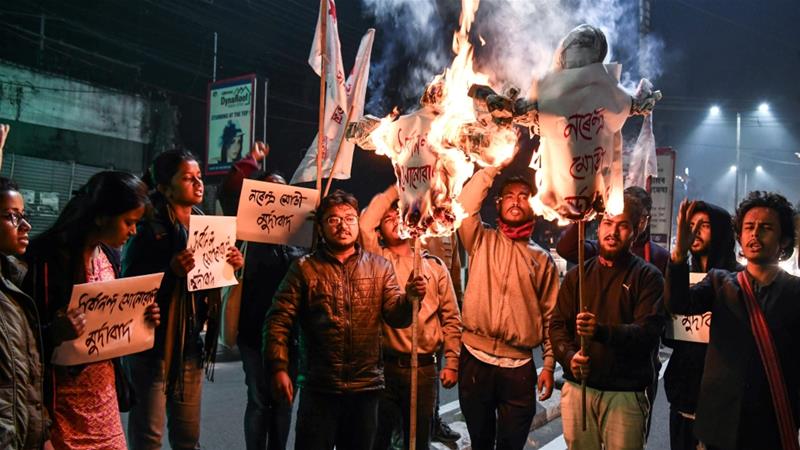India’s recent citizenship law amendments allow the selective inclusion of non-Muslim minorities from the country’s Muslim majority neighbors Bangladesh, Pakistan, and Afghanistan. Hindu, Christian, Sikh, Parsee, Buddhist, and Jain immigrants from these three countries who entered India without the needed documents before 2014 will be conferred with permanent citizenship after six years of residency.


Prime Minister Narendra Modi has artfully signaled India as a savior of “oppressed” minorities in South Asia and reengineered parliamentary democracy to serve his electoral agendas.
Modi’s rise and his fanning of nationalistic fires is close on the heels of global populism and the emergence of the far-right. Britain’s exit from the European Union, Donald J. Trump’s wall on the Mexican border, the rise of hardliners in Europe, and the coming to power of Jair Bolsonaro in Brazil are all illustrations of the same trend. They all call upon “nation building” as the strongest expression of segregation.
By invoking fears and demonizing specific immigrants, leaders instill in voters a deep rejection of secular values as foreign while simultaneously positioning the intellectuals as outdated left-liberal social justice warriors.
There is nothing new about national citizenship relying on selective inclusions and aggressive expulsions. This dual logic shows how nations have historically relied on the labors of undocumented migrants and refugees without granting them rights, as well as violently conquered land, delegitimizing those who originally resided on it.
Hindu Refugees
Yet, Modi’s offer to grant citizenship to approximately 31,000 immigrants within India is not a humanitarian gesture. It does not guarantee economic and cultural integration. India’s refugee-to-citizenship history reminds us that the country was hardly a sanctuary for refugees.
Even for the Hindu refugees who arrived following the 1947 partition of British India – a violent division that created a Hindu majority India and a Muslim majority Pakistan – no state in the Indian federation desired the resettlement of Hindu refugees on their land.
For decades, these people lived in squalid conditions in camps and squatted along railway lines and in the marshes on the fringes of Indian cities like Calcutta. The Indian state dispersed and controversially resettled people in remote islands.
Both state-led and refugee-initiated resettlements displaced Muslims and indigenous communities from their lands. The transformation of Hindu refugees into Indian citizens progressed alongside violent police action against protesting refugees and India’s aggressive deportations of Muslims to Pakistan, especially in the 1960s.
Portraying India as Country of Refuge
In portraying India as a refuge, Modi cleverly glosses over the country’s dismal human rights records towards its citizens. This includes the extremist Hindu groups’ attacks on and lynching of Muslims, as well as the rising atrocities against Hindu low-caste and indigenous populations.
Religious freedoms and the freedom of expression have declined. While reaching out to the Sikhs persecuted in Pakistan and sheltered in India, the Indian nation also forgets its own carnage against the Sikhs in 1984.
India’s new citizenship laws intentionally ignore the fact that when people resettle under distressing circumstances, they carry with them far more than only their religious identities. For instance, in the state of Assam in Northeast India, Hindu refugees from East Pakistan and later Bangladesh are still regarded as primarily Bengali instead of Hindu.
Modi’s actions of bringing “Delhi at the doors of the Northeast” have fuelled protests. In Assam, the new citizenship laws will push the existing threshold of legal immigration up. In seeking to bring Delhi closer to the geographically disconnected Northeast India, Modi seeks to impose the narrow Hindu-Muslim religious divide to Assam. This divide cannot capture Assam’s diversity and syncretic religions. There is no doubt that the government will continue to extend the year of arrivals for electoral gains.
Indian Muslims
In one masterstroke, Modi has cleverly whipped up the imagination of his India as a refuge for non-Muslims while subtly calling attention to Indian Muslims, who comprise 14.2 percent of the population.
His supporters surface in the virtual world, vociferously and dangerously demanding that Bangladesh, Pakistan, and Afghanistan should legislate a reciprocal arrangement and resettle Indian Muslims.
While all this can be dismissed as election-year gimmicks, the long-term implications are ominous. A second partition is something India can’t afford.


